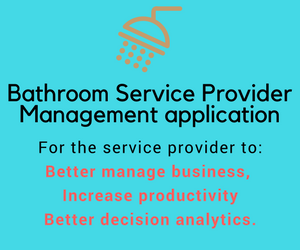Subscribe to our mailing list
(Laravel) Bathroom Service Provider’s Management System
Executive Summary

Step 1 – Defining the client’s Problem
The client, a USA based bathroom repairing and fittings service providers used to use a lot of pen paper and excel sheets, to manage different aspects of their enterprise. Using this traditional old way was time-consuming and ineffective. Apart from same repetitive time-consuming tasks (like manually creating appointment slips, calculating payouts for technicians and marketer, etc) they missed Key decision-making analysis about the business, like year-on-year or MoM revenue, daily/weekly/monthly targets achieved, profitable target market, technician and marketers productivity and other key aspects of the business.
So, they needed an application to help them overcome all these and take their enterprise towards focusing on what really matters.
Step 2 – Defining the Requirement
The client was looking to build a system to manage their enterprise.
This involved managing of pricing for different types of services based on markets; managing clients, leads, prospects; managing technicians/staffs, their availability; managing sellers/marketers and their payouts, deals, and projects status (Pending, In Progress, Completed), creating appointment letters, other useful business entities.
Also, getting key actionable insights about the various entities of the enterprise to help them take better decision.
Step 3 – Offering a perfect Solution
- The Web Fosters team coordinates with the client and came with the solution of developing a bespoke/custom application tailored according to their needs.
- We agreed to have different modules for different entities like User, Technician, Customer, Pricing Structure, Deal & projects and other as per the needs. Also, few settings to modify the global behavior of the application.
- The solution was flexible, as all the current requirement can be integrated into the system and also it can be enhanced in future to meet the changing needs.
- We agreed to have user Role-based access checks to restrict users from unauthorized access.
Step 4 – Working Process
- Initially, we discussed his business process/flow, pricing methodology, appointment templates. This helped us to get an overview of their enterprise.
- Different modules were analyzed. Based on it, the behavior and related key functionalities for them were noted.
- Technical database structure and development stack were chosen based on the requirement.
- A simplified system consisting of some base modules like User management, Technician management, Structure pricing and related CRUD was developed.
- As we followed scrum methodology, a regular demonstration of the working application was given to the client. This helped in making sure we are on right track toward solving the client problem.
- With each demonstration, we came up with feature enhancement to be done for making the system much better and effective. For example, some of them were like adding Google Maps with travel routes in projects to help navigate technician reach to the customer, full view calendar was added to get information on previous/today’s/upcoming projects, User can be added their leaves or block out days if they were not available and a lot more. This, of course, helped toward making it much better and robust.
- Complex project Appointment form was added, which help them to create much better and detailed appointment slips.
All calculation, like project pricing, Package, total cost, discount, deposits, miscellaneous fees, technician fees, marketer fees was auto-calculated based on the user input and customers marketplace. This helped them to save a huge time which was wasted to create appointment slips manually using excel sheets.
Step 5 – Delivering a Perfect Tool
- An enterprise Web application which helped them to manage all the essentials of their enterprise.
- Up to 50% save time and increase productivity.
- Better management of different resources.
- Increased focus on what truly matters, i.e providing service and not on bookkeeping of various resources.
- Key decision making analysis helped them take proper decisions.
Tools & Technical Stack
PHP 7, Laravel, MySQL, Bootstrap, jQuery, LAMP stack, HTML, CSS, Google Map, Full calendar, dbdesigner
